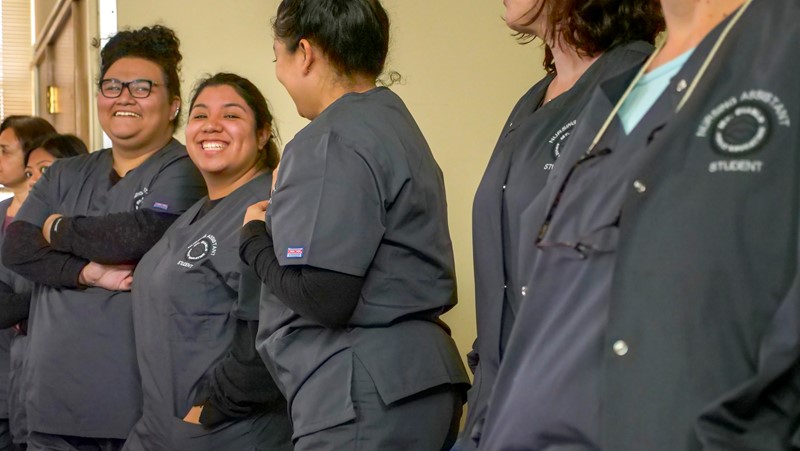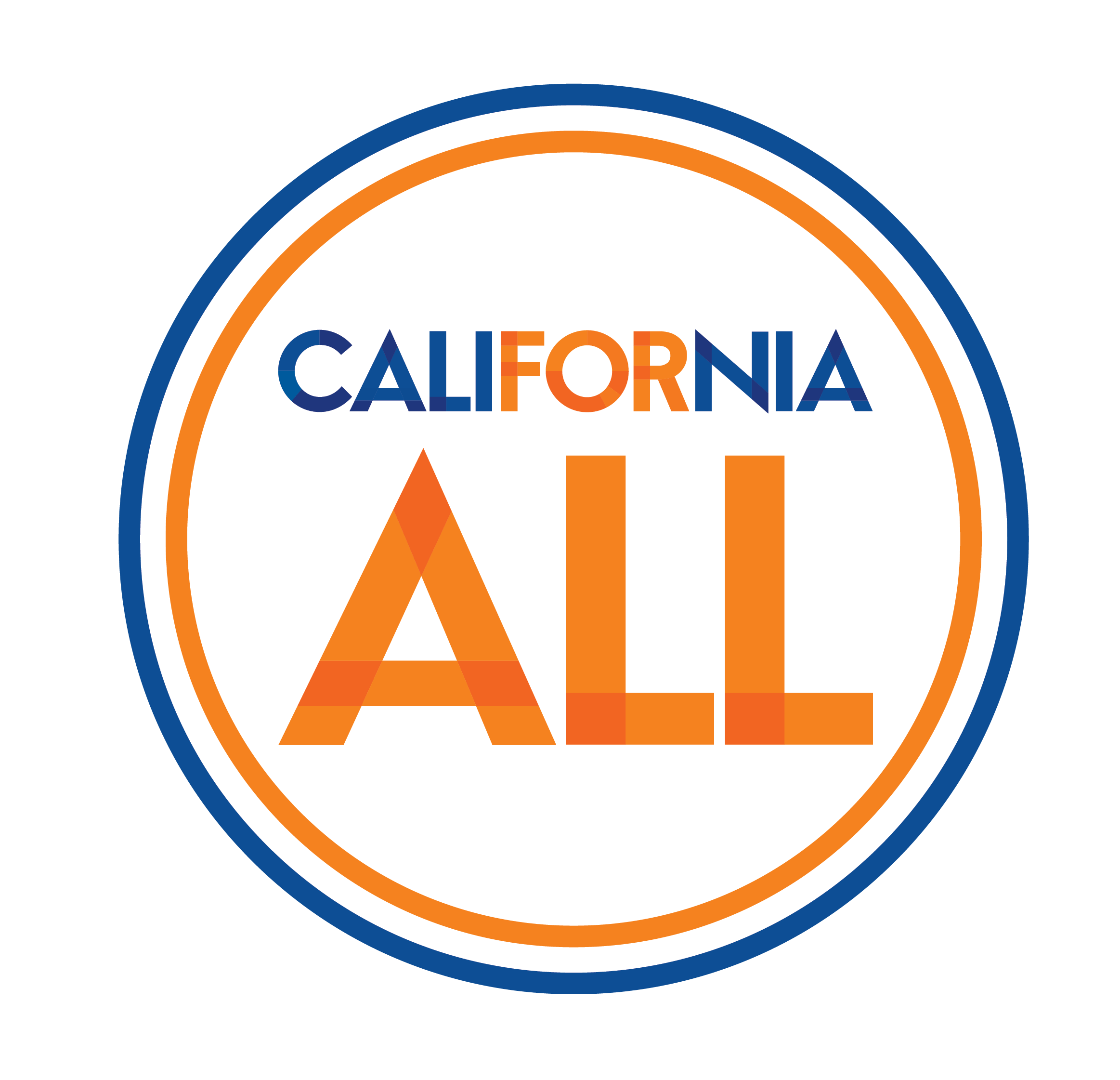Master Plan: 5 Bold Goals
Goal four for 2030
Goal four: Caregiving That Works
"We will be prepared for and supported through the rewards and challenges of caring for aging loved ones."
View Goal Four’s data indicators and track our progress at the Data Dashboard for Aging.
At some point in our lives, most Californians will seek care from family, friends, or paid caregivers. Likewise, most Californians will also have the privilege and responsibility of caring for an olderloved one. The COVID-19 pandemic has meant even more of us are in one or both of those roles, in more challenging circumstances. Supporting caregiving for adults, like caregiving for children, is essential for family life, the economy, and a California for all ages.
Across California, almost five million family caregivers help their parents, spouses, and friends who need assistance with everyday tasks to live well in their homes and communities. Of these, almost 1.7 million are caring for someone with Alzheimer’s Disease or dementia, usually with little support or training. This constitutes about 4 billion hours of unpaid time, valued at $63 billion, each year. Women, particularly Black, Indigenous, Latino, and Asian-American women, are providing a disproportionately large share of this care – often while simultaneously caring for children. Households of color are more likely than white households to be multi-generational, which may indicate these families are more likely to be providing unpaid caregiving across the generations. As rewarding as this work may be, the time needed to care for a loved one can result in financial hardship and a decrease in lifelong Social Security earnings, which can continue the cycle of poverty and debt for low-income households. The emotional and physical stress of caregiving can also lead to poor health outcomes for the family caregiver.
Paid caregiving is essential to older adults’ ability to choose where to live. Caregivers provide direct care in many settings – in private homes, through community-based services like adult day centers, or in residential care homes, such as assisted living facilities or nursing homes. In the coming years, California will face a labor shortage up to 3.2 million paid direct care workers. Direct care workers earn less than half of California’s median annual income and one in four falls below the federal poverty line. Most caregiving jobs are held by women; many are immigrants, and they are twice as likely as other Californians to live in low-income households. Low wages, stress, and an elevated risk of job-related injury reduce prospects for financial stability for those employed in the caregiving workforce.
As the population age, and the need for caregiving increases, virtual caregiving and telehealth will become more vital for empowering aging adults, people with disabilities, and caregivers to age well at home. However, recent research has shown that older adults with dementia, hearing loss, and impaired vision may have a hard time using digital devices and programs designed without their needs in mind. The lessons from COVID-19’s rapid pivot to telehealth, coupled with California’s global leadership in the tech sector, have the potential to drive transformative advances in virtual care.
California will pursue Caregiving That Works through the below strategies and initiatives.
Strategy A: Family and Friends Caregiving
Family caregivers need supports – such as paid family leave, multilingual training resources, virtual care options, and respite – so that the role remains rewarding and caregivers can maintain health, well-being, and income while caring for a loved one. Given that lower-income women, particularly women of color, disproportionately provide family caregiving, resources and support should be tailored and prioritized accordingly.
-
Initiative 79
- Partner with the Caregiver Resource Centers, Area Agencies on Aging, and providers of services under Title IIIE of the Older Americans Act to ensure family caregiver assessments track equity metrics, focusing on reaching Black, Latino, Indigenous, Asian/Pacific Islander, and LGBTQ+ caregivers, as well as people with disabilities and Californians with the greatest economic and social needs. (Lead Agency: CalHHS)
-
Initiative 80
- Convene subject matter experts and people with lived experience as family caregivers to review training resources, and partner with stakeholders (government, community-based organizations, academia, labor, philanthropy) to develop a compendium of resources to meet the education and training needs of California’s diverse caregivers. (Lead Agency: CalHHS)
-
Initiative 81
- Utilize data from the LTSS Dashboard, the DHCS Medi-Cal and CDA Non-Medi-Cal Home and Community-Based Services Gap Analyses and Multiyear Roadmaps, and the California Health Interview Survey to understand the unmet needs of family caregivers with a focus on addressing the emotional burden of care and the need for respite support. (Lead Agency: CalHHS)
-
Initiative 82
- Develop a Statewide Caregiver Equity Roadmap and Strategy to position California as a lead state partner in the federal Administration for Community Living’s National Strategy to Support Family Caregivers, including strategies to address the financial burdens of caregiving and the risk to caregivers’ financial security. (Lead Agency: CalHHS)
Strategy B: Good Caregiving Jobs Creation
The caregiving workforce can be grown through caregiver training and professional development opportunities, along with livable wages, job placement support, and improved job quality. Higher wages will help paid caregivers work toward financial security, alleviate economic disparities, and better reflect the true value of their work.
-
Initiative 83
- Promote innovative models for Community Health Workers to serve older adults and people with disabilities in home and community-based settings, targeting underserved populations with a focus on equity, including through Medicare Fee-for-Service and Medicare Advantage delivery systems. (Lead Agency: CalHHS, LWDA)
-
Initiative 84
- Develop a direct care inventory of evidence-informed, competency based training, career ladder, and certification programs that are accessible statewide, aimed at promoting person-centered, culturally, and linguistically responsive training designed for older adults, people with disabilities, family caregivers, and populations with complex needs, including persons with dementia. Explore opportunities to expand career pathways for direct care staff, including the feasibility of linking training to wage increases. (Lead Agency: CalHHS, LWDA)
-
Initiative 85
- Diversify the pipeline for direct care workers in home and community settings by testing and scaling emerging models to meet the need, as funding allows. (Lead Agency: CalHHS, LWDA)
Strategy C: Virtual Care Expansion
New technologies, many pioneered in California, are paving the way for innovations in personal devices, smart home and community design, telehealth and more, and have the potential to help support caregiving and aging well across the state, nation, and globe.
-
Initiative 86
- Leverage technology, innovative practices, and program flexibilities that enable older adults, people with disabilities, and family caregivers to access virtual care (tele-health) through Medi-Cal, particularly in underserved communities. (Lead Agency: CalHHS)
text
Caregivers of family and friends too often have to choose between their own health and financial needs and caring for a loved one. Caregivers need culturally competent options that not only improve their own health and quality of life, but also those of the person for whom they are caring. Accessible and affordable long term services and supports, paid family leave, resources and training, and assistance navigating services will improve the lives of millions of caregiving families in California
In 2023-2024, California will advance ninety-five new Master Plan for Aging initiatives, building upon the work of the plan’s first two years. Each initiative features a designated area of focus:
Deliver
Analyze
Communicate
For a list of the 2021-2022 Initiatives, please view the original Master Plan for Aging report or the 2021 MPA Initiatives Progress Report.

Healthcare Career Pathways (HCP) is a collaborative partnership with Ombudsman Services of Contra Costa, Solano and Alameda, Opportunity Junction, and Mt. Diablo Adult Education formed to address the critical shortage of healthcare workers. HCP provides quality clinical and classroom training to students, leading them to the certification they need to become skilled caregivers in their community.
.png)
